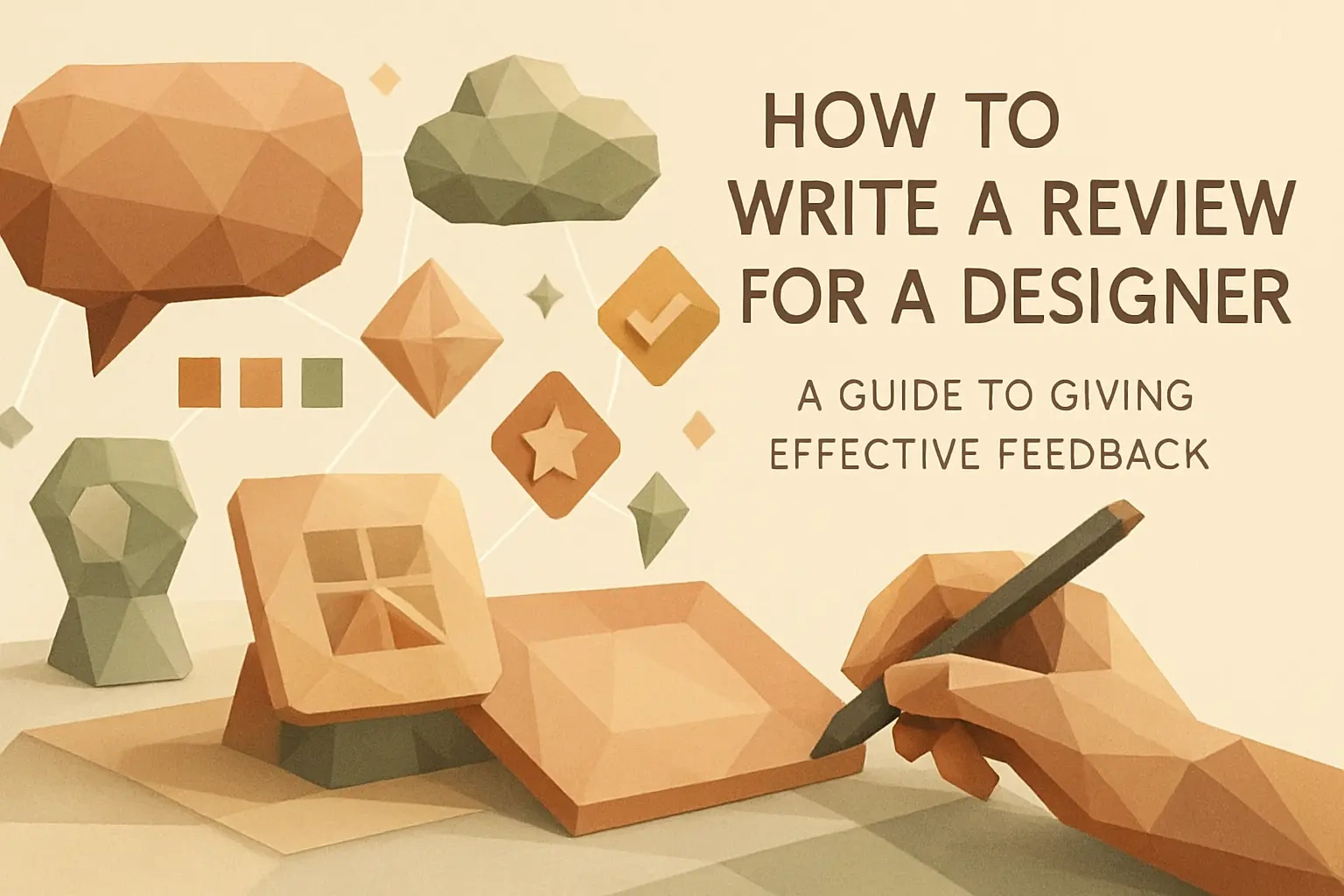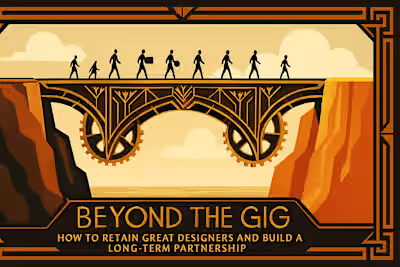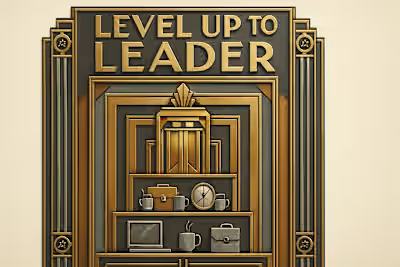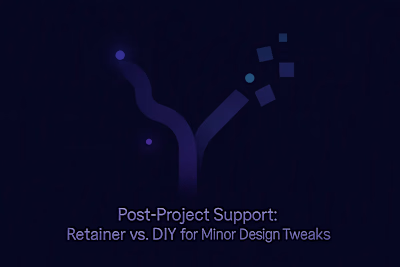How to Write a Review for a Designer: A Guide to Giving Effective Feedback

How to Write a Review for a Designer: A Guide to Giving Effective Feedback
The Anatomy of a Powerful Review
Be Specific About the Project
Comment on the Process, Not Just the Final Product
Highlight Specific Strengths
How to Give Constructive Criticism
Focus on the Work, Not the Person
Be Objective and Actionable
Use the 'Sandwich' Method (If Appropriate)
Why Your Review Matters
It Builds Trust and Credibility
It Strengthens Your Relationship
Conclusion
References
How to Write a Review for a Designer: A Guide to Giving Effective Feedback
After a project ends, you're often asked to leave a review. It's easy to dash off a quick "Great work!" but a thoughtful, well-written review is one of the most valuable things you can provide. It not only helps the designer improve and win future work, but it also helps other clients make informed hiring decisions. Whether you've just worked with someone you found when you decided to hire Figma designers or collaborated with a long-term partner, this guide will show you how to write a review that truly counts.
A well-crafted review strengthens your relationship and makes it easier to re-hire great designers for future projects. This feedback loop is also critical when considering post-project support and ongoing collaboration opportunities.
The Anatomy of a Powerful Review
A great review goes beyond a simple star rating. It tells a story about the project and the process, providing context and specific details that future clients can actually use.
Think of your review as a mini case study. You're not just saying whether the experience was good or bad. You're painting a picture of what it was like to work with this designer. This helps both the designer showcase their strengths and other clients understand if they're the right fit.
Be Specific About the Project
Start by briefly describing the work. Generic statements don't help anyone. Instead of writing "designed a website," try something like "[Designer's Name] designed a 5-page e-commerce website for our new skincare line." This immediately gives context to your feedback.
Being specific serves multiple purposes. First, it shows you actually paid attention to what the designer delivered. Second, it helps potential clients with similar projects understand the designer's capabilities. And third, it gives the designer concrete examples they can point to in their portfolio.
For example, you might write: "Sarah redesigned our mobile app's onboarding flow, reducing it from 8 screens to 4 while maintaining all essential information. She also created a cohesive design system that we're now using across all our digital products."
This level of detail transforms a forgettable review into a powerful testimonial. It shows scope, results, and the designer's ability to think systematically.
Comment on the Process, Not Just the Final Product
How was the collaboration? This is often more important than the final deliverables. Mention key aspects of the working relationship. Were they a great communicator? Did they meet deadlines? Did they incorporate feedback well?
Process-oriented details are incredibly helpful for other clients. A designer might create beautiful work, but if they're impossible to reach or miss every deadline, that's crucial information. On the flip side, a designer who keeps you updated, asks smart questions, and delivers on time deserves recognition for those professional skills.
Consider mentioning things like:
How they handled revisions
Their communication style and frequency
Whether they proactively suggested improvements
How they managed project timelines
Their approach to understanding your business needs
Real-world example: "Marcus sent weekly progress updates every Monday, which kept our team aligned. When we requested major changes halfway through, he handled it professionally and helped us understand the timeline impact. His Figma files were always organized and easy for our developers to reference."
Highlight Specific Strengths
Point out what they did exceptionally well. Generic praise like "great designer" doesn't help anyone. Was it their creativity in solving a complex UX problem? Their expertise in creating a beautiful and functional design system? Their ability to translate vague ideas into concrete visuals?
Specific strengths might include:
Problem-solving ability: "She identified a major navigation issue we hadn't even noticed and proposed an elegant solution"
Technical expertise: "His knowledge of accessibility standards helped us reach WCAG compliance without sacrificing aesthetics"
Business understanding: "She didn't just design pretty screens – she understood our conversion goals and designed accordingly"
Collaboration skills: "He facilitated design workshops that got our entire team aligned on the vision"
The more specific you are, the more valuable your review becomes. It helps the designer understand their strengths and gives future clients clear expectations.
How to Give Constructive Criticism
Even in a positive review, you might have feedback for improvement. Delivering this constructively is an art that helps the designer grow without damaging the relationship.
Remember, the goal isn't to vent frustrations or settle scores. It's to provide feedback that helps the designer improve their craft and better serve future clients. When done well, constructive criticism shows you care about their professional development.
Focus on the Work, Not the Person
Frame your feedback around the project's outcomes and design choices, not the designer's personal abilities. The goal is to be helpful, not critical of them as a person.
Instead of: "They don't understand modern design trends" Try: "The initial concepts felt a bit dated, though they quickly adapted after we shared some contemporary references"
Instead of: "They're not good at typography" Try: "The typography choices in the first draft needed refinement, particularly the heading hierarchy"
This approach keeps the feedback professional and actionable. It also acknowledges that design is subjective and iterative. What matters is how the designer responded to feedback and whether the final result met your needs.
Be Objective and Actionable
Avoid vague statements like "I didn't like the colors." This doesn't help anyone understand what went wrong or how to improve. Instead, try something like, "The contrast on the primary call-to-action button was a bit low, making it hard to read. We might explore a more accessible color combination in the future."
Objective feedback includes:
Specific examples of what didn't work
The impact it had on the project
Suggestions for improvement (when appropriate)
Here's a framework for constructive feedback:
Identify the specific issue: "The mobile navigation took up too much screen space"
Explain the impact: "This left little room for content on smaller devices"
Acknowledge any constraints: "I understand we had many menu items to accommodate"
Suggest a path forward: "A hamburger menu or bottom navigation might work better next time"
This approach shows you understand design challenges while still providing useful critique.
Use the 'Sandwich' Method (If Appropriate)
A common technique is to sandwich a piece of constructive criticism between two positive comments. This can soften the delivery and make the feedback more receptive, but ensure the praise is genuine.
Example: "Jennifer's creativity in the initial concept phase was outstanding – she presented ideas we'd never considered. While the first round of revisions took longer than expected, she communicated delays clearly and the final designs exceeded our expectations. Her attention to detail in the component library will save us hours of development time."
The sandwich method works because it:
Starts on a positive note, making the reader receptive
Delivers criticism in context, not as the main message
Ends positively, leaving a good overall impression
But be careful not to make it feel formulaic. If your praise feels forced or generic, it undermines the whole review. Only use this method when you genuinely have positive things to say alongside your critique.
Why Your Review Matters
Taking a few extra minutes to write a detailed review has a ripple effect that extends far beyond the individual designer.
In today's gig economy, reviews are currency. They help talented professionals build their reputation and find better clients. They help clients make informed decisions. And they raise the bar for everyone by rewarding quality work and professionalism.
It Builds Trust and Credibility
Your authentic feedback helps good designers build their reputation, which in turn helps the entire freelance marketplace. When talented designers can showcase genuine, detailed reviews, it becomes easier for quality to rise to the top.
Think about your own hiring process. Don't you read reviews before choosing a designer? Your detailed feedback becomes part of their professional story. It helps them:
Win better projects
Charge appropriate rates
Build long-term client relationships
Improve their skills based on feedback
For the broader community, quality reviews:
Make it easier to identify truly skilled professionals
Reduce the risk for clients hiring designers
Encourage higher standards of work
Create accountability in the freelance marketplace
When you write a thoughtful review, you're not just helping one designer. You're contributing to a system that rewards excellence and helps everyone make better decisions.
It Strengthens Your Relationship
A thoughtful review shows the designer you value their work and partnership, making them more likely to prioritize working with you again in the future. This might seem counterintuitive – won't a great review make them too busy for you? In reality, designers remember clients who took time to write meaningful feedback.
Benefits of strengthening the relationship include:
Priority access: When you need quick turnarounds, they'll remember your support
Better rates: Designers often offer better rates to repeat clients who value their work
Deeper understanding: Each project builds on the last, reducing onboarding time
Proactive improvements: Designers who feel valued often go above and beyond
Writing a good review is an investment in your future projects. It shows professionalism and appreciation that designers remember when choosing between clients.
Conclusion
Writing an effective review doesn't require literary genius. It just requires honesty, specificity, and a few minutes of thoughtful reflection. By following this guide, you can write reviews that truly help designers improve, assist other clients in making informed decisions, and strengthen your own professional relationships.
Remember these key points:
Be specific about the project and process
Balance positive feedback with constructive criticism
Focus on objective, actionable insights
Take the extra time to write thoughtfully
Your review is more than just feedback – it's a professional courtesy that benefits everyone involved. The designer gets valuable insights and credibility. Future clients get helpful information. And you build stronger relationships for future collaborations.
Next time you finish a project, resist the urge to dash off a quick rating. Instead, invest a few minutes in writing a review that makes a difference. Your thoughtfulness will be remembered and appreciated long after the project ends.
References
Like this project
Posted Jul 6, 2025
Your review is powerful. Learn how to write a fair, specific, and constructive review for your Figma designer that helps them and other clients.









